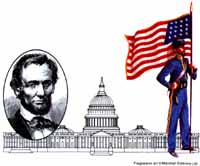|
Geography
Fort Sumter had been fired upon and taken by Confederate forces during Chapter 2, and the War between the States had begun.
The war, of course, was the topic of most every conversation. Rallies were held all over the country, and every trip to town was met with the anticipation for news of the war.
The Union Army, under pressure from Washington to crush the  Southern rebellion, marched toward Richmond, but met Confederate forces coming north at a railway junction near Manassas. Southern rebellion, marched toward Richmond, but met Confederate forces coming north at a railway junction near Manassas.
Battle of Bull Run
What ensued was the first major land battle in the Civil War. To the South, it became known as the Battle of Manassas, the location of a Confederate base. To the North, it was named after Bull Run, the creek that flowed through the battlefield.
- Number of Forces = 60,680
- North = 28,450
- South = 32,230
- Estimated Casualties = 4,700
- North = 2,950
- South = 1,750
- Result = Confederate Victory
There was a lull in the war following the Battle of Bull Run. Neither side was anxious for further confrontation, and many were expecting no further hostilities until spring.
General Johnston, in command of Confederate forces, believed that his troops were too small to undertake a major offensive, while General McClellan, commander of the Union Army of the Potomac, was busy training his troops and preparing for the defense of Washington.
Concerned about the Confederate presence in the Leesburg area, McClellan suggested that General Charles Stone make a ďslight demonstrationĒ with the hopes of moving the Confederates.
Stone sent troops under the command of Colonel Charles Devens to reinforce Harrisonís Island, located on the Potomac River just off the Ballís Bluff shoreline, sending a smaller scouting party to scout inland from the Virginia shore toward Leesburg.
Battle of Wilsonís Creek
The battle, known as the Battle of Wilsonís Creek by the Union, and as the Battle of Oak Hills by the Confederates, began on August 10th, 1861.
The emotional impact of Wilsonís Creek was harder on the Creighton family not because of the facts of the battle itself, but because it occurred in Missouri, nearer to their native Illinois.
Union Brig. General Nathaniel Lyonís Army of the West was camped at Springfield, Missouri, with Confederate troops under the command of Brig. General Ben McCulloch approaching. Both sides had determined to attach one another.
At about 5:00 a.m. on the 10th, General Lyon attacked the Confederates at Wilsonís Creek, about 12 miles southwest of Springfield.
The Confederates fell back briefly, then regrouped, stabilizing their positions. Taking the offensive, the Confederates attacked the Union forces three times that day, but failed to break through the Union lines. Lyon was killed during the battle, and replaced by Major Samuel Sturgis.
Following the third Confederate attack, they withdrew. Sturgis, realizing that his men were exhausted and low on ammunition, retreated to Springfield, and the Confederates elected not to pursue.
- Number of Forces = 17,000
- North = 11,600
- South = 5,400
- Estimated Casualties = 480
- Result = Confederate Victory
Battle of Ballís Bluff
The battle began on the morning of October 21st, when the Confederates forced the Union troops back toward the bluff. The Union forces were no match for the Southern troops. Later in the afternoon, Union Colonel Edward Baker, a lifelong friend of President Lincoln, was killed with a shot to the head.
The Northern troops were forced into the Potomac River, where some escaped by swimming to safety or floating on logs, while others drowned or were shot by Confederate troops firing from the bluffs. More than 500 Union soldiers were captured.
- Number of Forces = 3,600
- North = 2,000
- South = 1,600
- Estimated Casualties = 1,070
- Captured = 555
- Missing = 150
- Result = Confederate Victory
The Battle of Ballís Bluff was small in terms of the number of soldiers involved, but its significance was great. Following, as it did, decisive Confederate victories at Fort Sumter and Bull Run, any hope that the Union had for a short resolution to the war were shattered, while the South found reason to hope for a strong Confederacy.
|

